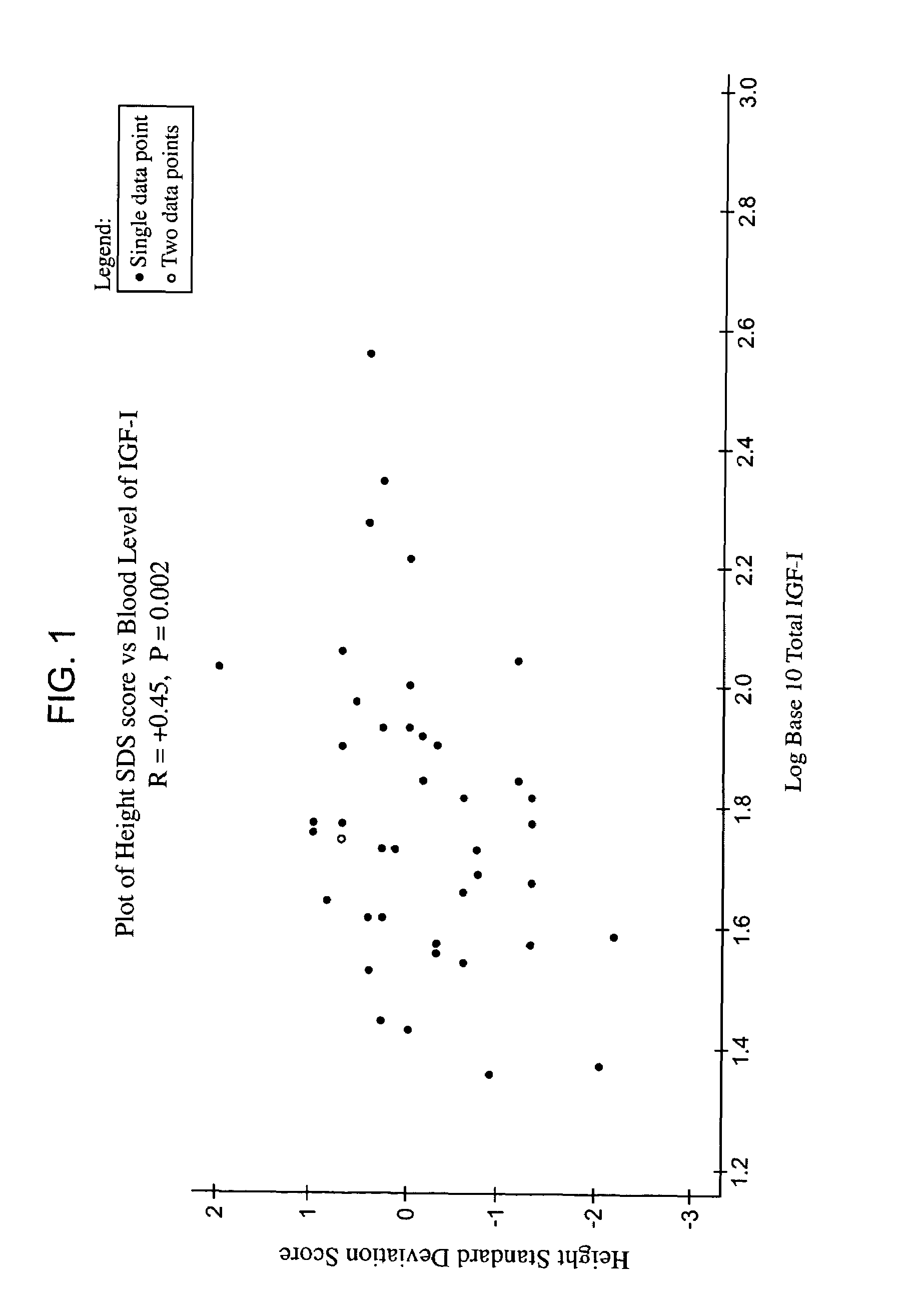Methods for treatment of insulin-like growth factor-1 (IGF-1) deficiency
a technology treatment method, which is applied in the field of treatment of insulinlike growth factor-1 (igf1) deficiency, can solve the problems of igf deficiency, achieve the effects of improving the metabolism of human patients, increasing growth rate, and alleviating symptoms
- Summary
- Abstract
- Description
- Claims
- Application Information
AI Technical Summary
Benefits of technology
Problems solved by technology
Method used
Image
Examples
example 1
Interrelationships Among Various Measures Related to the GH-IGF Axis
[0144]Data from large surveillance studies of the use of GH, such as the National Cooperative Growth Study (NCGS) can be helpful in determining patient populations that will respond to IGF-1 treatment, especially with associated substudies looking at referred but untreated patients and using centralized assay results. One such substudy of the NCGS (Substudy VI) noted that short children undergoing hormonal testing were found as a group to have low IGF-1 levels (IGF-1 SDS=−1.7±1.7, mean±SD) despite relatively normal maximum stimulated GH levels. One of the goals of this substudy was to explore the interrelationships among various measures related to the GH-IGF axis, including stimulated GH, GHBP, IGF-1 and IGF binding protein 3 (IGFBP-3). The data surprisingly showed a substantial proportion of referred short children have primary IGFD, that is, are GH sufficient but IGF-1 deficient.
[0145]NCGS substudy VI was designe...
example 2
Relationship between Height and Blood Concentration of IGF-1
[0177]The aim of this study was to examine the relationship in adults between height and the blood concentration of IGF-1 and then treat the patients with rhIGF-1.
[0178]Subjects
[0179]Individuals who had previously been diagnosed as suffering from Type II diabetes mellitus (DM) were selected for study. The 44 subjects were men and women 30 to 70 years of age with a hemoglobin A1c level of greater than 8.0%. The subjects were all receiving treatment for hyperglycemia with oral medication(s) only.
[0180]Blood was drawn and height was measured. Total IGF-1 was measured by radioimunoassay after extracting the sample with acid-ethanol. Hemoglobin A1c levels were also measured. Systolic blood pressure was also measured.
[0181]The patients were then treated with rhIGF-1, as described in Example 1, at either 20 or 40 micrograms per kilogram twice daily by subcutaneous injection for 12 weeks.
[0182]Results
[0183]FIG. 1 shows the positive...
example 3
Administration of rhIGF-1
[0189]An animal study was conducted administering rhIGF-1 for the life-time of animals to study the long-term effects of rhIGF-1 in normal animals.
[0190]It has been shown that the efficacy of GH is limited in humans with normal GH secretion. Such children with normal GH secretion (so-called patients with idiopathic short stature) show very small growth responses to GH. It might be predicted that the long-term efficacy of rhIGF-1 might be limited by such effects as rhIGF-1 causing an acceleration of bone age, which would cause the epiphyses of the long bones to close early which would limit the ability to grow, or of rhIGF-1 inhibiting GH secretion and thereby having a self-limiting effect on growth.
[0191]This Example shows a long-term study in animals that is equivalent to similar long-term treatment in growing children. Because the epiphyses of the long bones of rats stay open for a very long period relative to their life span, it is possible for rats to gr...
PUM
| Property | Measurement | Unit |
|---|---|---|
| concentration | aaaaa | aaaaa |
| concentration | aaaaa | aaaaa |
| particle size | aaaaa | aaaaa |
Abstract
Description
Claims
Application Information
 Login to View More
Login to View More - R&D
- Intellectual Property
- Life Sciences
- Materials
- Tech Scout
- Unparalleled Data Quality
- Higher Quality Content
- 60% Fewer Hallucinations
Browse by: Latest US Patents, China's latest patents, Technical Efficacy Thesaurus, Application Domain, Technology Topic, Popular Technical Reports.
© 2025 PatSnap. All rights reserved.Legal|Privacy policy|Modern Slavery Act Transparency Statement|Sitemap|About US| Contact US: help@patsnap.com

